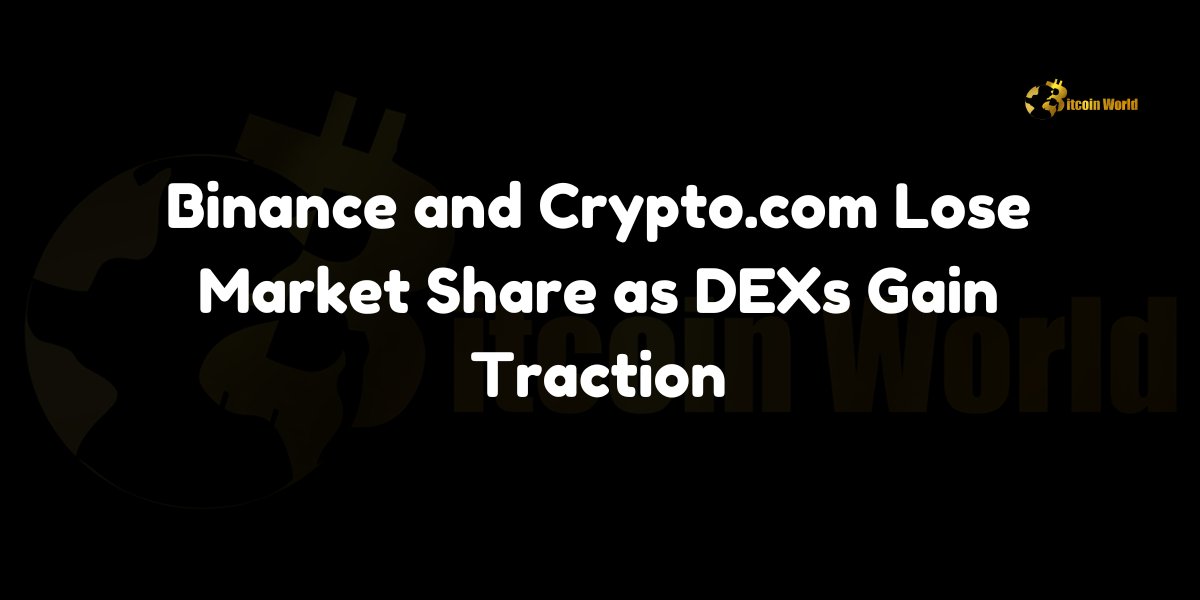Binance and Crypto.com Lose Market Share as DEXs Gain Traction
In a notable shift within the cryptocurrency exchange landscape, Binance and Crypto.com are experiencing a decline in their market share. According to a 0XScope research report shared with Cointelegraph, Binance’s spot trading volume has decreased from 52.5% to 39.54%, and its derivatives market has fallen from 50.9% to 42.5%. Meanwhile, smaller exchanges such as Bybit and OKX have been gaining ground. Additionally, decentralized exchanges (DEXs) now account for 13.6% of the spot trading volume, underscoring a growing preference for decentralized platforms among traders.
Overview of Market Share Decline
The decline in market share for major centralized exchanges like Binance and Crypto.com signals a significant trend in the cryptocurrency trading environment. As traders increasingly turn to decentralized alternatives, the dominance of large centralized platforms is being challenged. This shift is driven by several factors, including enhanced security features, lower fees, and greater control over assets offered by DEXs.
Key Statistics
Binance Spot Trading Volume: Decreased from 52.5% to 39.54%
Binance Derivatives Market: Dropped from 50.9% to 42.5%
DEXs Spot Trading Volume: Now at 13.6%
Smaller Exchanges Gaining Ground: Bybit and OKX
Factors Driving the Shift Toward DEXs
Enhanced Security and Privacy
Decentralized exchanges offer heightened security measures by eliminating the need for a central authority to hold users’ funds. This reduces the risk of hacks and thefts that have plagued centralized platforms in the past. Additionally, DEXs often require less personal information, enhancing user privacy and appealing to those concerned about data breaches and surveillance.
Lower Fees and Cost Efficiency
DEXs typically have lower trading fees compared to their centralized counterparts. By eliminating intermediaries, decentralized platforms can pass on cost savings to users, making trading more affordable. This is particularly attractive to high-frequency traders and those managing large volumes of transactions.
Greater Control Over Assets
With DEXs, users maintain full control over their private keys and, consequently, their assets. This autonomy appeals to crypto enthusiasts who prioritize self-custody and the elimination of counterparty risk. The ability to trade directly from one’s wallet without depositing funds into an exchange further enhances this control.
Innovation and Advanced Features
DEXs are at the forefront of integrating innovative features such as automated market makers (AMMs), liquidity pools, and yield farming. These advancements provide users with more diverse trading options and opportunities to earn passive income, attracting a broader range of investors and traders.
Rise of Smaller Centralized Exchanges
While Binance and Crypto.com face declining market shares, smaller exchanges like Bybit and OKX are capitalizing on this shift. These platforms offer competitive fees, diverse trading pairs, and robust security measures, positioning themselves as viable alternatives to the industry giants.
Bybit’s Growth Strategy
Bybit has focused on expanding its derivatives trading options and enhancing its user interface to attract both novice and experienced traders. By prioritizing customer support and introducing educational resources, Bybit has successfully increased its user base and trading volume.
OKX’s Market Penetration
OKX has leveraged strategic partnerships and global expansion efforts to penetrate new markets. By offering a wide range of crypto assets and continuously upgrading its platform, OKX has managed to retain and grow its market share despite the competitive pressures.
Implications for the Cryptocurrency Exchange Landscape
Increased Competition and Innovation
The decline of major exchanges like Binance and Crypto.com fosters a more competitive environment, encouraging all players to innovate and improve their offerings. This competition benefits users by driving down fees, enhancing security, and introducing new features that enhance the trading experience.
Regulatory Considerations
As DEXs gain prominence, regulatory bodies are paying closer attention to decentralized platforms. Ensuring compliance with anti-money laundering (AML) and know your customer (KYC) regulations remains a challenge for DEXs, potentially influencing their operational models and the services they offer.
Future of Centralized vs. Decentralized Exchanges
The ongoing shift toward DEXs suggests a future where both centralized and decentralized exchanges coexist, each catering to different segments of the market. Centralized exchanges may continue to dominate in terms of trading volume and user base, while DEXs carve out niches based on security, privacy, and innovative trading options.
Expert Opinions
Dr. Emily Carter, Blockchain Analyst
“The decline in Binance and Crypto.com’s market share is indicative of a broader trend towards decentralization in the crypto industry. DEXs offer compelling advantages in terms of security and user control, which are becoming increasingly important to traders.”
Mark Thompson, Financial Strategist
“The rise of DEXs represents a maturation of the cryptocurrency market. As traders seek more autonomy and lower costs, decentralized platforms are well-positioned to capture a significant portion of the trading volume, challenging the dominance of centralized exchanges.”
Sarah Lee, DeFi Researcher
“Decentralized exchanges are driving innovation in the crypto space, introducing features that traditional exchanges are only beginning to adopt. This dynamic environment benefits the entire ecosystem by fostering competition and pushing all players to enhance their services.”
Future Outlook
Continued Growth of DEXs
Decentralized exchanges are expected to continue growing, driven by technological advancements and increasing user demand for secure and cost-effective trading solutions. As DEXs integrate more sophisticated features and improve their user interfaces, they will attract a wider audience, further diminishing the market share of centralized exchanges.
Evolution of Centralized Exchanges
Centralized exchanges like Binance and Crypto.com will need to adapt to the changing landscape by incorporating more decentralized features, enhancing security protocols, and reducing fees to stay competitive. Some may also explore hybrid models that combine the benefits of both centralized and decentralized platforms.
Regulatory Developments
The regulatory environment for DEXs will play a crucial role in shaping the future of the cryptocurrency exchange landscape. Clear and balanced regulations can provide a framework for DEXs to operate more securely and transparently, fostering trust and encouraging broader adoption.
Conclusion
The declining market share of Binance and Crypto.com, coupled with the rising traction of DEXs, marks a significant evolution in the cryptocurrency exchange ecosystem. As decentralized platforms continue to gain popularity, driven by their inherent advantages in security, cost efficiency, and user control, the traditional dominance of centralized exchanges is being challenged. This shift not only enhances competition and innovation within the industry but also provides traders with more diverse and secure options for managing their digital assets.
As the cryptocurrency market continues to mature, the interplay between centralized and decentralized exchanges will shape the future dynamics of trading, investment, and financial innovation. Stakeholders must navigate these changes thoughtfully, balancing the benefits of decentralization with the operational strengths of centralized platforms to foster a robust and inclusive crypto trading environment.
To stay updated on the latest trends and developments in the cryptocurrency exchange landscape, explore our article on latest news, where we cover significant events and their impact on digital assets.





